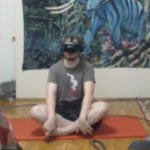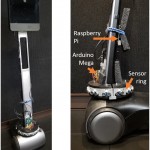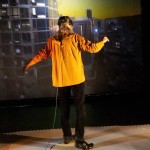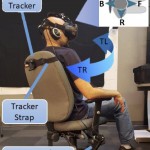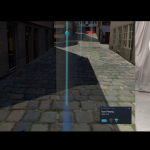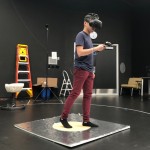Ashu Adhikari
Biography
Ashu Adhikari joined the iSpace team in Fall 2018 as a graduate student. His research focuses on creating embodied locomotion interfaces in virtual reality.
He is a Professional Engineer with a bachelor’s degree in Electronics and Communication Engineering.
Projects
We are investigating and creating a new virtual reality (VR) experience, 'Awedyssey', for the promotion and enhancement of well-being. Today, digital technology pervasively intersects with our daily lives, and VR stands out as a digital tool capable of fostering positive emotion like awe, self-transcendence, and authentic social connection.
Connecting with nature is very important for our mental...
Sipping the Virtual Elixir: An autoethnographic close reading of Ayahuasca Kosmik Journey a self-transcendent virtual experience.
Recently self-transcendent experiences are gaining interest in the research community because of their ability to support wellbeing. Experiences of self-transcendence can be transformative, leading to a diminishment of self/ego and the feeling of unity with n...
How can we improve telepresence systems (such as conference robots) so they are not just "zoom on wheels" but actually allow users to feel more present and navigate more easily around remote environments?"
FeetBack: Augmenting Robotic Telepresence with Haptic Feedback on the Feet
Telepresence robots allow people to participate in remote spaces, yet they can be difficult to manoeuvre with people ...
HyperJumping in Virtual Vancouver: Combating Motion Sickness by Merging Teleporting and Continuous VR Locomotion in an Embodied Hands-Free VR Flying Paradigm
Motion sickness, unintuitive navigation, and limited agency are critical issues in VR/XR impeding wide-spread adoption and enjoyable user experiences. To tackle these challenges, we present HyperJump, a novel VR interface merging advantages ...
Can more embodied and leaning-based interfaces help support concurrent locomotion and interaction in VR when physical walking isn't feasible?
Physical walking is often considered the gold standard for VR travel whenever feasible. However, especially for larger-scale virtual travel the free-space walking areas are typically too small, thus requiring handheld controllers to navigate, which ...
SIRIUS (Scientific International Research in Unique Terrestrial Station) is a series of on-land isolation experiments modelling long-term spaceflight in order to assess the psychophysiological effects of isolation on a crew and prepare for long-duration spaceflights, such as a trip to Mars. An 8-month-long isolation study commenced in Moscow on Nov 4th, 2021, where a crew of 6 people (from Roscosm...
Hand-held VR controllers are widely available and used, however they can contribute to unwanted side-effects, such as increased cybersickness, disorientation, and cognitive load. Here, we show how a leaning-based interfaces ("HeadJoystick") can help improve user experience, usability,and performance in diverse ground-based navigation including three complementary tasks: reach-the-target, follow-th...
Here we propose a hybrid interface that allows user to seamlessly transition between a slow 'continuous' mode and a fast 'hyperjump' mode. The interface aims to maintain the immersion, presence, accuracy and spatial updating of continuous locomotion while adding the travel efficiency and minimizing the cybersickness.
Continuous locomotion in VR provides uninterrupted optical flow, which mimics re...
Flying has been a dream for mankind for millenia - but flying interfaces for VR, gaming, and teleoperation (e.g., drones) typically rely on cumbersome double-joystick/gamepads and do not allow for intuitive and embodied flying experiences. Here, we develop low-cost embodied flying interfaces that adapt leaning-based motion cueing paradigms thus freeing up hands for additional tasks beyond just na...
Here we propose a novel and cost-effective setup of a leaning-based interface ("NaviBoard") that allows people to efficiently navigate virtual environments - with performance levels matching the gold standard of free-space walking, without any increase in motion sickness
Abstract Walking has always been the most common locomotion mode for humans in the real world. As a result, it has also been co...
Gamifying Research - Researchifying Games
While traditional experimental paradigms offer tight stimulus control and repeatability, then tend to be a bit boring and removed from many real-world situations, which can limit real-world transferability of results.
How can we bring together the methodological strenghs of research with the intrinsic motivation of playfulness and gaming?
The ...
Publications
http://ispace.iat.sfu.ca/wp-content/plugins/zotpress/
37904
Sirius. (2021, October 1). [Curated & peer-reviewed Virtual Reality Exhibition]. V-Unframed, Vancouver, BC, Canada.
https://www.alliancefrancaise.ca/v-unframed/the-artworks/sirius/
37904
Stepanova, Ekaterina R., K. Brauns, A Friedl-Werner, Noah Miller, John Desnoyers-Stewart, Ashu Adhikari, Bernhard E. Riecke, and Alexander C. Stahn. 2022. “A Neurophenomenological Approach to Better Understand the Effects of Eliciting Positive Experiences in Virtual Reality.” Poster presented at the Phenomenological Methods in Neuroscience and Consciousness Research workshop, University of Zürich.
37904
Riecke, Bernhard E, David Clement, Denise Quesnel, Ashu Adhikari, Daniel Zielasko, and Markus von der Heyde. 2022. “HyperJumping in Virtual Vancouver: Combating Motion Sickness by Merging Teleporting and Continuous VR Locomotion in an Embodied Hands-Free VR Flying Paradigm.” In Siggraph ’22 Immersive Pavilion, 1–2. Vancouver, BC, Canada: ACM. https://doi.org/10.1145/3532834.3536211.
37904
Riecke, Bernhard E., Ashu Adhikari, Daniel Zielasko, Alexander Bretin, Markus von der Heyde, and Ernst Kruijff. 2021. “HyperJump: Merging Teleporting and Continuous VR Locomotion into One Paradigm.” Talk presented at the ICSC 2021: 8th International Conference on Spatial Cognition, Rome, Italy.
37904
Riecke, Bernhard E, Abraham M Hashemian, Ashu Adhikari, Ivan Aguilar, Ernst Kruijff, and Markus von der Heyde. 2021. “Simultaneous Locomotion and Interaction in VR: Walking > Leaning > Controller.” Talk presented at the ICSC 2021: 8th International Conference on Spatial Cognition, Rome, Italy.
https://youtu.be/jzoaBAd6gPY.
37904
Adhikari, Ashu, Bernhard E. Riecke, Abraham M. Hashemian, Thinh Nguyen-Vo, Ernst Kruijff, and Markus von der Heyde. 2021. “Embodied VR Flying Improves Spatial Orientation While Reducing Cybersickness.” Talk presented at the ICSC 2021: 8th International Conference on Spatial Cognition, Rome, Italy.
https://youtu.be/FbmE4SEISWU.
37904
Hashemian, Abraham M., Ashu Adhikari, Alexander Bretin, Ivan Aguilar, Ernst Kruijff, Markus von der Heyde, and Bernhard E. Riecke. 2021. “Is Walking Necessary for Effective Locomotion and Interaction in VR?” In 2021 IEEE Conference on Virtual Reality and 3D User Interfaces Abstracts and Workshops (VRW), 395–96. Lisbon, Portugal: IEEE. https://doi.org/10.1109/VRW52623.2021.00084.
37904
Adhikari, Ashu, Daniel Zielasko, Ivan Aguilar, et al. 2022. “Integrating Continuous and Teleporting VR Locomotion into a Seamless ‘HyperJump’ Paradigm.” IEEE Transaction on Visualization and Computer Graphics TVCG 29 (12): 5265–81. https://doi.org/10.1109/TVCG.2022.3207157.
37904
Miller, Noah, John Desnoyers-Stewart, Ekaterina R. Stepanova, et al. 2023. “Awedyssey.” Curated Mixed Reality Exhibition. Cosmic Nights: Humans in Space, H.R. MacMillan Space Centre, H.R. MacMillan Space Centre, November 23.
https://events.sfu.ca/event/37966-cosmic-nights-humans-in-space.
37904
Miller, Noah, John Desnoyers-Stewart, Ekaterina R. Stepanova, et al. 2021. “Sirius.” Curated & peer-reviewed Virtual Reality Exhibition. V-Unframed, Vancouver, BC, Canada, Vancouver, BC, Canada, October 1.
https://www.alliancefrancaise.ca/v-unframed/the-artworks/sirius/.
37904
Miller, Noah, Ekaterina R. Stepanova, John Desnoyers-Stewart, et al. 2023. “Awedyssey: Design Tensions in Eliciting Self-Transcendent Emotions in Virtual Reality to Support Mental Well-Being and Connection.” Proceedings of the 2023 ACM Designing Interactive Systems Conference (New York, NY, USA), DIS ’23, July 10, 189–211. https://doi.org/10.1145/3563657.3595998.
37904
Kitson, Alexandra J., John Desnoyers-Stewart, Noah Miller, Ashu Adhikari, Ekaterina R. Stepanova, and Bernhard E. Riecke. 2020. “Can We Trust What’s Real? Using Fiction to Explore the Potential Dissociative Effects of Immersive Virtual Reality.” Paper presented Ethics of MR’20 Workshop at ACM CHI 2020 (Exploring Potentially Abusive Ethical, Social and Political Implications of Mixed Reality Research in HCI), Honolulu, HI, USA. (Honolulu, HI, USA).
37904
Hashemian, Abraham M, Ashu Adhikari, Ivan A Aguilar, Ernst Kruijff, Markus von der Heyde, and Bernhard E. Riecke. 2024. “Leaning-Based Interfaces Improve Simultaneous Locomotion and Object Interaction in VR Compared to the Handheld Controller.” IEEE Transactions on Visualization and Computer Graphics (TVCG) 30 (8): 4665–82. https://doi.org/10.1109/TVCG.2023.3275111.
37904
Adhikari, Ashu, Daniel Zielasko, Alexander Bretin, Markus von der Heyde, Ernst Kruijff, and Bernhard E. Riecke. 2021. “Integrating Continuous and Teleporting VR Locomotion into a Seamless ‘HyperJump’ Paradigm.” 2021 IEEE Conference on Virtual Reality and 3D User Interfaces Abstracts and Workshops (VRW) (Lisbon, Portugal), 370–72. https://doi.org/10.1109/VRW52623.2021.00074.
37904
Jones, Brennan, Jens Maiero, Alireza Mogharrab, et al. 2020. “FeetBack: Augmenting Robotic Telepresence with Haptic Feedback on the Feet.” Proceedings of the 2020 International Conference on Multimodal Interaction (Utrecht, Netherlands), ICMI ’20, October 21, 194–203. https://doi.org/10.1145/3382507.3418820.
37904
Adhikari, Ashu, Abraham M. Hashemian, Thinh Nguyen-Vo, Ernst Kruijff, Markus von der Heyde, and Bernhard E. Riecke. 2021. “Lean to Fly: Leaning-Based Embodied Flying Can Improve Performance and User Experience in 3D Navigation.” Frontiers in Virtual Reality 2: 1–22. https://doi.org/10.3389/frvir.2021.730334.
37904
Hashemian, Abraham M., Ashu Adhikari, Ernst Kruijff, Markus von der Heyde, and Bernhard E. Riecke. 2021. “Leaning-Based Interfaces Improve Ground-Based VR Locomotion in Reach-the-Target, Follow-the-Path, and Racing Tasks.” IEEE Transaction on Visualization and Computer Graphics TVCG, 1–22. https://doi.org/10.1109/TVCG.2021.3131422.
37904
Hashemian, A., M. Lotfaliei, A. Adhikari, E. Kruijff, and Bernhard E. Riecke. 2020. “HeadJoystick: Improving Flying in VR Using a Novel Leaning-Based Interface.” IEEE Transactions on Visualization and Computer Graphics 28 (4): 1792–809. https://doi.org/10.1109/TVCG.2020.3025084.


